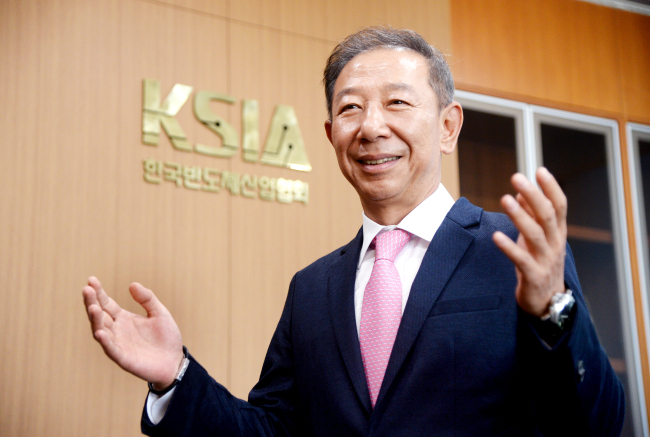Some find reasons for South Korea’s competitiveness in the memory chip industry in Korean people’s genetic traits: diligence, meticulousness, tenacity.
But Nam Ki-man, vice chairman of the Korea Semiconductor Industry Association, takes a different approach.
A radial shape of the chipmaking ecosystem is what has made Korea a powerhouse for memory chips, Nam explained.
“Like the shape of the Avenue des Champs-Elysees in Paris, Korean semiconductor businesses are forming a radial shape of business relations, which has been the key to producing the world’s best-quality memory chips,” Nam said.
“Centering around semiconductor companies with fabrication lines (for example, Samsung Electronics and SK hynix), equipment providers, material suppliers and fabless chip designers coexist in the radial ecosystem that is suitable for highly sophisticated co-works like chip manufacturing.”
Aside from the technological comparisons of Korean companies with US competitors like Intel and Qualcomm in the system chip market, they have an innately different ecosystem -- a typical supply chain consisting of a chipmaker and lower-tier suppliers, the expert said.
“Compared to the chain ecosystem, the radial one requires a lot more cooperation and communication among related partners to produce a single product,” Nam said. “Incredibly complex management of this ecosystem is the essence of the Korean memory chip industry.”
 |
Nam Ki-man, vice chairman of the Korea Semiconductor Industry Association (Park Hyun-koo/The Korea Herald) |
Nam, a former government official at the Ministry of Trade, Industry and Energy, also acknowledged the unique corporate culture of Korean conglomerates as a reason behind the country’s success in the semiconductor industry.
“Quick decision-making, outstanding vision, swift and efficient execution capabilities are also major reasons when we look at the companies individually,” he added.
As of the second quarter of this year, Samsung beat Intel for the first time in 24 years, in terms of combined sales and operating profits.
Industry watchers see the rise as the result of successful development of next-generation technologies for dynamic random-access memory, known as DRAM and 3-dimensional NAND flash memory chips.
Since SK hynix is a member of a global consortium to acquire Toshiba’s NAND flash memory unit, the Korean chipmakers’ presence in the memory world is expanding ever more than before.
Combined sales of Samsung and SK hynix are forecast to hit a record high of 100 trillion won this year, according to the financial industry.
Amid such an upbeat mood in the chipmaking industry, Nam encouraged both large and smaller semiconductor businesses in the country to take advantage of the upcoming wave of Industry 4.0.
“We expect to see explosive growth in demand for system chips in the era of the fourth industrial revolution across various sectors such as biotechnology, communications, low power solutions, medical diagnosis, and so forth,” he said. “Intel and conventional leaders will still exist, but the system chip sector will start to be led by first movers who find niche markets for the newly emerging services and products that entail application of chips.”
These days, Korean chip engineers are paying keen attention to new trends in other industries such as the automobile industry in order to grasp ideas about what kind of new chips will be needed for connected cars and autonomous driving, Nam explained.
“The last two years have been intriguing to detect unusual trends in the industry,” he said. “While conventional factors that used to derive growth of chip demand -- from personal desktop computers, laptops and smartphones -- seem to have been overshadowed by new, unexpected factors such as those from artificial intelligence, bid data, Internet of Things and autonomous driving sectors.”
To the question of when this super cycle would end, the industry veteran tilted his head, saying “unexplainable.”
“In the very long term, we can say the industry’s growth is heading onwards and upwards, but it is very hard to predict how the market would change next year,” he added.
Nam joined the KSIA in 2014, which is a non-government organization promoting interests and growth of semiconductor businesses in Korea. At the Ministry of Trade, Industry and Energy, Nam served as chiefs of trade and industry policies until April 2013. He is an expert on economic development and public economics with a Master‘s degree from Wisconsin University.
By Song Su-hyun (
song@heraldcorp.com)
The Korea Herald is publishing a series of articles dissecting the status and plans of South Korea’s leading semiconductor businesses that are shifting the shape of the global market. This is the second installment. -- Ed.





![[Exclusive] Hyundai Mobis eyes closer ties with BYD](http://res.heraldm.com/phpwas/restmb_idxmake.php?idx=644&simg=/content/image/2024/11/25/20241125050044_0.jpg)
![[Herald Review] 'Gangnam B-Side' combines social realism with masterful suspense, performance](http://res.heraldm.com/phpwas/restmb_idxmake.php?idx=644&simg=/content/image/2024/11/25/20241125050072_0.jpg)

